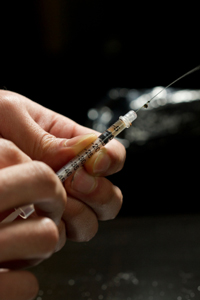May 6, 2013
Dealing With Addiction

By Michael D. Shaw
In the broadest sense, a drug is any chemical substance that can affect the functioning of an organism, and those related entities (such as bacteria, fungi, and viruses) that might infect it. In his book Drugs and Society (1967), the late highly-regarded sociologist and medical ethicist Bernard Barber laid out the scope of the problem…
Not only can nearly anything be called a “drug,” but things so called turn out to have an enormous variety of psychological and social functions—not only religious and therapeutic and ‘addictive,’ but political and aesthetic and ideological and aphrodisiac and so on. Indeed, this has been the case since the beginning of human society. It seems that always and everywhere drugs have been involved in just about every psychological and social function there is, just as they are involved in every physiological function.
“Always and everywhere,” indeed. As noted in an article from 2005 by psychiatrist Tammy Saah, “Archaeological records indicate the presence of psychotropic plants and drug use in ancient civilizations as far back as early hominid species about 2 million years ago.” She then goes on to mention very early use of psychotropic drugs in what is now called Thailand, Australia, and the Americas.
Drug abuse can be thought of as the excessive, maladaptive, or addictive use of drugs for non-medical purposes despite social, psychological, and physical problems that may arise from such use. The list of commonly abused substances is extensive, and while headed up by psychotropic compounds—opiates and opioids, hallucinogens, barbiturates, cocaine, amphetamines, tranquilizers, the several forms of cannabis, alcohol, nicotine, and solvent inhaling—also includes anabolic steroids and numerous legal drugs. It is noted that competitors in the earliest Greek Olympic Games used herbs and fungi—many of them hallucinogenic—to improve their performance.
Chemical dependency is thought to arise from at least these two phenomena, operating in concert:
1. The hijacking of the brain’s reward circuitry, which evolved to reinforce critical behaviors such as eating and mating.
2. The effect of tolerance, whereby increasingly larger doses must be consumed to maintain the drug’s desired effects. In some cases, absent an increase in dosage, withdrawal symptoms can occur.
As to treatment modalities, while detoxification (“detox”) is important, authorities emphasize that it is only one part of the process. According to Treatment Improvement Protocol 45, as developed by the Center for Substance Abuse Treatment:
Detoxification is a set of interventions aimed at managing acute intoxication and withdrawal. At the same time, detoxification is a form of palliative care (reducing the intensity of a disorder) for those who want to become abstinent or who must observe mandatory abstinence as a result of hospitalization or legal involvement. For some patients it represents a point of first contact with the treatment system and the first step to recovery. Treatment/rehabilitation, on the other hand, involves a constellation of ongoing therapeutic services ultimately intended to promote recovery for substance abuse patients.
The use of individual and group psychotherapy is quite common in drug rehabilitation programs, along with careful utilization of opiate agonists Methadone and Suboxone—two drugs not exactly free from side effects. Conventional residential treatment programs generally involve highly-structured schedules and sound nutrition, often in idyllic settings. Nonetheless, most of these programs are also quick to post disclaimers such as this one:
An estimated 90 percent of people who have recovered from an addiction to drugs or alcohol will eventually relapse. Depending on the severity of the relapse, you may have to begin the process of addiction treatment and recovery from the very beginning.
There is also an alternative rehab movement, jump-started by the unusual properties of an extract from the Tabernanthe iboga plant, known as ibogaine. As the story goes, back in the early 1960s, a hard-core drug addict named Howard Lotsof tried some ibogaine, and was amazed to discover that even after the drug’s hallucinogenic effects wore off, he no longer craved heroin. And, there were no withdrawal symptoms, either.
Unfortunately, there were also enough observed side effects—and even some fatalities—so the FDA banned the drug in 1967. Afterwards, further trials were conducted, but the drug is still a Schedule I substance. Ibogaine is legal in many other countries, including Canada and Mexico, and alternative rehab centers have been established using this herb. Many of these also adhere to holistic modalities, and eschew the grueling psychotherapy sessions, as well as the demanding work requirements, typical of conventional rehab programs.
One such program is called The Holistic Sanctuary, whose mission is to “Naturally stop addiction, end dependency, and heal our clients with up to date healing therapies that have no side effects. We don’t rely on outdated 12 step AA disease model theory, toxic medication therapy, or the one size fits all approach.”
Founder Johnny Tabaie, himself a former addict, coming from a family with addiction problems, told me this:
We offer a comprehensive and thorough series of treatments, with over 20 different holistic therapies that help arrest, reverse, and heal the main source of dependency. My treatment, the Pouyan Method, is the only protocol I have seen reverse addiction, with supporting proof on brain scans. We use only herbs, sun, oxygen, super-foods, energy, and 100% natural non-invasive methods to end cravings associated with drug withdrawal, depression and anxiety. Please visit The Holistic Sanctuary’s website to learn more about our expertise, success stories and facilities that complement the work we do on a daily basis.
Bold claims, to be sure, but given the poor success rate of conventional rehab, alternative approaches are definitely needed.

